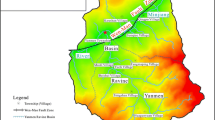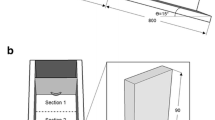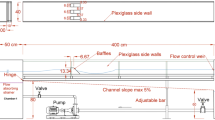Abstract
Slit dams are open-type structures used to mitigate debris-flow hazards by constricting the flow and attenuating the kinetic energy. However, slit dams are often filled up as they are designed to impede debris volume instead of reducing kinetic energy of debris flows. To better understand the regulation function of slit dams against debris flows, physical model tests were carried out using a 7-m-long flume. The water content and relative post spacing were varied to discern their influence on the regulation function. Results reveal that the velocity attenuation and trapping efficiency is strongly controlled by water content and relative post spacing. Water content fundamentally reflects the degree of liquefaction (effetive grain-contact stress) and capacity of energy dissipation of debris flows. When water content < 26%, relative post spacing has a noticeable effect on velocity attenuation, trapping efficiency, and run-out distance. In contrast, when water content ≥ 26%, the influence relative post spacing is negligible. Furthermore, a new relationship between velocity attenuation and trapping efficiency for the design of slit dams is proposed to avoid the slit dam being easily filled up by sediments contained in debris flows.












Similar content being viewed by others
References
Armanini A, Larcher M, and Odorizzi M (2011) Dynamic impact of a debris flow front against a vertical wall. In Proceedings of the 5th international conference on debris-flow hazards mitigation: mechanics, prediction and assessment, pp. 1041–1049 Padua, Italy
Baldwin JE, Donley HF, Howard TR (1987) On debris flow/avalanche mitigation and control, San Francisco Bay area, California. Rev Eng Geol 7:223–236
Chanson H (2004) Sabo check dams-mountain protection systems in Japan. Intl J River Basin Management 2(4):301–307
Chehata D, Zenit R, Wassgren CR (2003) Dense granular flow around an immersed cylinder. Phys Fluids (1994-present) 15(6):1622–1631
Choi CE, Ng CWW, Song D, Kwan JHS, Shiu HYK, Ho KKS, Koo RCH (2014a) Flume investigation of landslide debris–resisting baffles. Can Geotech J 51(5):540–553
Choi CE, Ng CWW, Law RP, Song D, Kwan JSH, Ho KKS (2014b) Computational investigation of baffle configuration on impedance of channelized debris flow. Can Geotech J 52(2):182–197
Choi CE, Ng CWW, Au-Yeung SCH, Goodwin G (2015) Froude scaling of landslide debris in flume modelling. Landslides 12(6):1197–1206
Choi CE, Goodwin G, Ng CWW, Chu HK, Kwan JSH, Pun WK (2016) Coarse granular flow interaction with slit-structures. Géotechnique Lett 6(4):1–8
Choi SK, Lee JM, Kwon TH (2018) Effect of slit-type barrier on characteristics of water-dominant debris flows: small-scale physical modeling. Landslides 15(1):111–122
Cui P (1999) Impact of debris flow on river channel in the upper reaches of the Yangtze River. Int J Sediment Research 14(2):201–203
Cui P, Zeng C, Lei Y (2015) Experimental analysis on the impact force of viscous debris flow. Earth Surf Process Landf 40(12):1644–1655
Cui YF, Zhou XJ, Guo CX (2017a) Experimental study on the moving characteristics of fine grains in wide grading unconsolidated soil under heavy rainfall. J Mt Sci 14(3):417–431
Cui Y, Chan D, Nouri A (2017b) Coupling of solid deformation and pore pressure for undrained deformation–a discrete element method approach. Int J Numer Anal Methods Geomech 41(18):1943–1961
Cui Y, Choi CE, Liu H, Ng CWW (2018) Effects of particle size of monodispersed granular flows impacting a rigid barrier. Nat Hazards 91(3):1179–1201
Han W, Ou G (2006) Efficiency of slit dam prevention against non-viscous debris flow. Wuhan Univ J Nat Sci 11(4):865–869
Hauksson S, Pagliardi M, Barbolini M, Jóhannesson T (2007) Laboratory measurements of impact forces of supercritical granular flow against mast-like obstacles. Cold Reg Sci Technol 49(1):54–63
He S, Liu W, Li X (2016) Prediction of impact force of debris flows based on distribution and size of particles. Environ Earth Sci 75(4):298
Heller V (2011) Scale effects in physical hydraulic engineering models. J Hydraul Res 49(3):293–306
Heumader J (2000) Technical debris-flow countermeasures in Austria-a review. Proceedings, Second International Conference on Debris-Flow Hazards Mitigation: Mechanics Prediction, and Assessment. pp. 443–464. TaiPei, Taiwan: ASCE
Hübl J, Fiebiger G (2005) Debris-flow mitigation measures. In Debris-flow hazards and related phenomena. Springer Berlin Heidelberg, pp: 445–487
Hübl J, Holzinger G (2003) Development of design basis for crest open structures for debris flow management in torrents: miniaturized tests for the efficiency estimation of debris flow breakers. WLS Report
Hübl J, Suda J, Proske D (2009) Debris flow impact estimation. Proceedings of the 11th international symposium on water management and hydraulic engineering, pp. 1-4. Ohrid, Macedonia
Hürlimann M, McArdell BW, Rickli C (2015) Field and laboratory analysis of the runout characteristics of hillslope debris flows in Switzerland. Geomorphology 232:20–32
Iverson RM (1997) The physics of debris flows. Rev Geophys 34(3):244–296
Iverson RM (2015) Scaling and design of landslide and debris-flow experiments. Geomorphology 244:9–20
Iverson RM, George DL (2015) Modelling landslide liquefaction, mobility bifurcation and the dynamics of the 2014 Oso disaster. Géotechnique 66(3):175–187
Iverson RM, Logan M, Denlinger RP (2004) Granular avalanches across irregular three-dimensional terrain: 2. Experimental tests. J Geophys Res Earth Surf 109:F01015. https://doi.org/10.1029/2003JF000084
Iverson RM, Logan M, LaHusen RG, Berti M (2010) The perfect debris flow? Aggregated results from 28 large-scale experiments. J Geophys Res Earth Surf 115:F03005. https://doi.org/10.1029/2009JF001514
Jaeggi MNR, Pellandini S (1997) Torrent check dams as a control measure for debris flows. In Recent developments on debris flows. Springer, Berlin Heidelberg, pp: 186–207
Johnson PA, McCuen RH (1989) Slit dam design for debris flow mitigation. J Hydraul Eng 115(9):1293–1296
Kwan JSH, Koo RCH, Ng CWW (2015) Landslide mobility analysis for design of multiple debris-resisting barriers. Can Geotech J 52(9):1345–1359
Law RPH, Choi CE, Ng CWW (2015) Discrete-element investigation of influence of granular debris flow baffles on rigid barrier impact. Can Geotech J 53(1):179–185
Lien HP (2003) Design of slit dams for controlling stony debris flows. International Journal of Sediment Research 18(1):74–87
Lien HP, Tsai FW (2000) Debris flow control by using slit dams. International Journal of Sediment Research 15(4):391–409
Lin YY, Jiang YZ (1988) Experimental study on the effectiveness of slit dam on debris flow. J Chin Soil Water Conserv 19(1):40–57 (in Chinese)
Lobovský L, Botia-Vera E, Castellana F, Mas-Soler J, Souto-Iglesias A (2014) Experimental investigation of dynamic pressure loads during dam break. J Fluids Struct 48:407–434
Malvern Instruments Ltd (2007) MAN0384-1.0 Mastersizer 2000 User Manual
McArdell BW, Bartelt P, Kowalski J (2007) Field observations of basal forces and fluid pore pressure in a debris flow. Geophys Res Lett 34(7):L07406. https://doi.org/10.1029/2006GL029183
McCoy SW, Kean JW, Coe JA, Staley DM, Wasklewicz TA, Tucker GE (2010) Evolution of a natural debris flow: in situ measurements of flow dynamics, video imagery, and terrestrial laser scanning. Geology 38(8):735–738
Mizuyama T (2008) Structural countermeasures for debris flow disasters. Int J Eros Control Eng 1(2):38–43
Mizuyama T, Suzuki H, Oikaka Y, Morita A (1988) Experimental study on permeable sabo dam. J Jpn Eros Control Eng Soc 41(2):21–25 (in Japanese)
MLR (Ministry of Land and Resources) (2004) Design standards for debris flow hazard mitigation measures (DZ/T0239-2004). Chinese Geological Survey, Ministry of Land and Resources, Beijing, China (in Chinese)
Ng CWW, Choi CE, Song D, Kwan JHS, Koo RCH, Shiu HYK, Ho KKS (2015) Physical modeling of baffles influence on landslide debris mobility. Landslides 12(1):1–18
Ni H, Tang C, Zheng W (2014) An overview of formation mechanism and disaster characteristics of post-seismic debris flows triggered by subsequent rainstorms in Wenchuan earthquake extremely stricken areas. Acta Geol Sin 88(4):1310–1328
Ono GI, Mizuyama T, Matsumura K (2004) Current practices in the design and evaluation of steel sabo facilities in Japan. Proceedings of the INTERPRAEVENT International Symposium. pp. VII: 243–264. Riva del Garda, Italy
Piton G (2016) Sediment transport control by check dams and open check dams in Alpine torrents (Doctoral dissertation, Grenoble Alpes)
Piton G, Recking A (2015) Design of sediment traps with open check dams. I: hydraulic and deposition processes. J Hydraul Eng 142(2):04015045
Savage SB, Hutter K (1989) The motion of a finite mass of granular material down a rough incline. J Fluid Mech 199:177–215
Scheidl C, Chiari M, Kaitna R, Müllegger M, Krawtschuk A, Zimmermann T, Proske D (2013) Analysing debris-flow impact models, based on a small scale modelling approach. Surv Geophys 34(1):121–140
Scott KM, Macías JL, Naranjo JA (2001) Catastrophic debris flows transformed from landslides in volcanic terrains: mobility, hazard assessment, and mitigation strategies. US Geol Surv Prof Pap 1630:1–59
Shima J, Moriyama H, Kokuryo H, Ishikawa N, Mizuyama T (2016) Prevention and mitigation of debris flow hazards by using steel open-type sabo dams. Int J Eros Control Eng 9(3):135–144
Sodnik J, Martinčič M, Mikoš M (2015) Are torrent check-dams potential debris-flow sources? In engineering geology for society and territory-volume 2. Springer, Cham, pp 485–488
Suwa H (1988) Focusing mechanism of large boulders to a debris-flow front. PhD thesis, Tokyo University, Tokyo, Japan
Takahashi T (2014) Debris flow: mechanics, prediction and countermeasures. CRC press, Boca Raton
White S, García-Ruiz JM, Martí C, Valero B, Errea MP, Gomez-Villar A (1997) The 1996 Biescas campsite disaster in the Central Spanish Pyrenees, and its temporal and spatial context. Hydrol Process 11(14):1797–1812
Zhang S (1993) A comprehensive approach to the observation and prevention of debris flows in China. Nat Hazards 7(1):1–23
Zhou GGD, Cui P, Chen HY (2013) Experimental study on cascading landslide dam failures by upstream flows. Landslides 10(5):633–643
Zhou GGD, Wright NG, Sun Q (2016) Experimental study on the mobility of channelized granular mass flow. Acta Geol Sin 90(3):988–998
Acknowledgements
The authors received financial support from the National Natural Science Foundation of China (grant no. 11672318), the Youth Innovation Promotion Association, CAS, and the Chinese Academy of Sciences (CAS) Pioneer Hundred Talents Program, and from the research grant T22-603/15-N provided by the Research Grants Council of the Government of Hong Kong SAR, China.
Author information
Authors and Affiliations
Corresponding author
Rights and permissions
About this article
Cite this article
Zhou, G.G.D., Hu, H.S., Song, D. et al. Experimental study on the regulation function of slit dam against debris flows. Landslides 16, 75–90 (2019). https://doi.org/10.1007/s10346-018-1065-2
Received:
Accepted:
Published:
Issue Date:
DOI: https://doi.org/10.1007/s10346-018-1065-2




